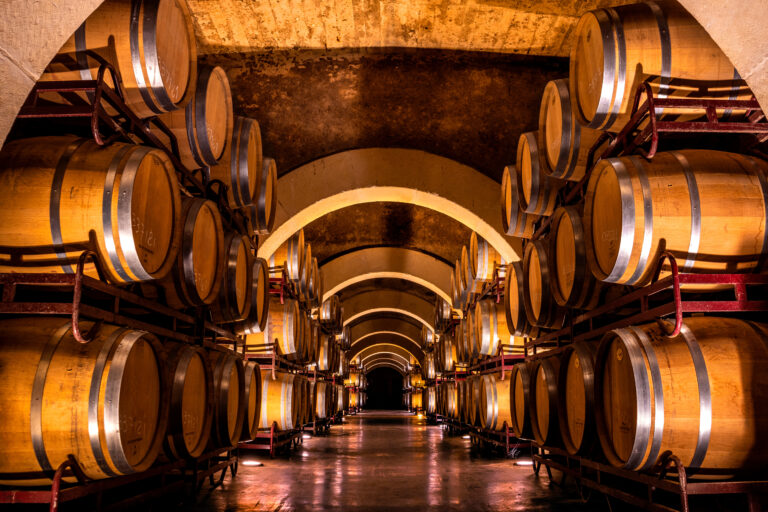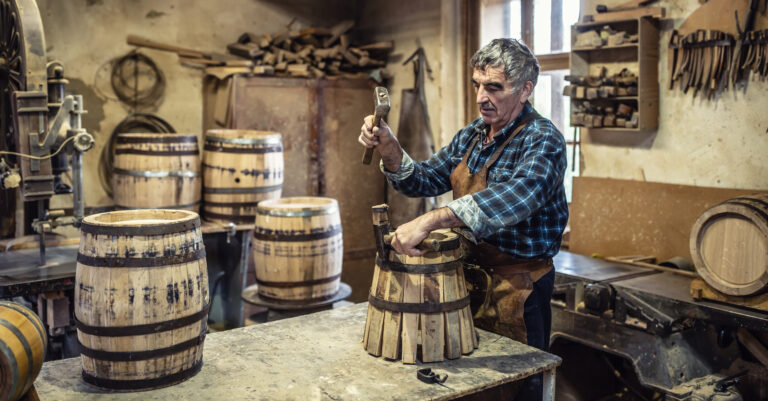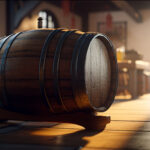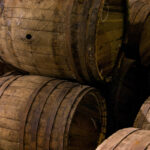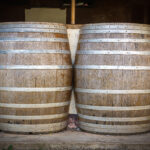Dreaming of turning a weathered whiskey barrel into a charming, rustic planter for your garden ideas? You’ve likely been searching online for the best approach, perhaps debating whether to line the inside of that characterful oak barrel before filling it with rich potting soil and your favorite plants. Well, the real answer is: it depends on what you’re after! You can absolutely embrace the simplicity of an unlined barrel planter, but let’s chat about a few things to keep in mind first. Stick with me as we dig into the pros and cons of lining versus letting your whiskey barrel planter go au naturel. By the time we’re done, you’ll have a solid understanding of what’s best for your unique gardening needs and local climate considerations. So, let’s get those hands dirty and jump into this rewarding DIY garden project!
What Exactly Is a Whiskey Barrel Planter?
A whiskey barrel planter is essentially a reclaimed oak barrel, once used to age fine whiskey, now given a new life as a distinctive garden container. These barrels bring a touch of rustic charm and undeniable character to any outdoor space, be it a sprawling garden or a cozy patio.
When it comes to size, you’ll typically find planter barrels in two main options: standard and half. A standard full barrel stands around 3 feet tall, while a half barrel is about 18 inches in height. Both sizes are fantastic for container gardening, the choice really depends on the space you have available and the number of plants you envision showcasing.
Some gardeners swear by lining their whiskey barrel planters before adding soil and plants. A liner acts as a barrier, helping to retain precious moisture and offering a degree of protection to the wood itself. However, whether or not to use a liner is a personal choice. If you decide to go this route, you can opt for a commercially available barrel liner, a sturdy trash bag with drainage holes, or even thick plastic sheeting.
For the best results in your whiskey barrel planter, aim to fill it about two-thirds full with a nourishing blend of quality potting soil and either compost or well-rotted manure. This combination provides the essential drainage and vital nutrients your plants need to flourish. With the right location, soil mix, and plant selection, a whiskey barrel planter can become a captivating focal point in your garden design for many years to come.
The Allure of Whiskey Barrel Planters for Gardens
There’s just something inherently appealing about whiskey barrel planters in a garden setting. Their rustic aesthetic fits perfectly with cottage garden ideas and farmhouse style decor. But does lining them truly make or break your planting success?
Whiskey barrels simply feel right in certain garden styles. Their weathered wood and those iconic metal bands evoke a sense of history and down-to-earth charm. You can find genuine antique barrels or beautifully crafted newer replicas made from various woods like oak, redwood, and pine.
These barrels prove to be ideal plant containers for a diverse range of greenery, from small trees and shrubs to vibrant herbs and colorful flowering plants. Their pleasing shape naturally complements rounded, mounding plant varieties.
The robust wood is designed to withstand the elements and will gracefully age outdoors, developing a lovely patina over time. This natural aging and weathering only add to their unique character. Regular sealing or staining is optional, depending on the look you prefer.
One of the great advantages of barrel planters is their inherent drainage. The slight gaps between the wooden staves usually allow for sufficient water runoff, often meaning you won’t need to drill extra drainage holes. Just be mindful not to overwater, especially in the initial stages of planting.
While the thought of lining a barrel might seem like a straightforward solution, it’s often unnecessary. Save yourself some time and money! With the right soil composition and selecting plants that are well-suited to your local climate zone, whiskey barrel planters can provide years of rustic garden charm without any liner at all. Now that’s appealing, isn’t it?
Do You Really Need to Line a Whiskey Barrel Planter?
So, the big question: Do you need to line a whiskey barrel planter? The short and honest answer is: it depends on several factors.
Porosity Considerations
Whiskey barrels are crafted from oak, a naturally porous wood. Over time, this wood can dry out, leading to shrinkage and the development of small cracks and potential leaks. Introducing a waterproof sealant, such as polyethylene plastic sheeting, as a liner can help significantly in preventing moisture loss from the soil while still allowing for essential drainage and air circulation.
For plant varieties that thrive in consistently moist soil, using a liner is generally a wise decision. It gives you greater control over the soil moisture levels within the barrel, eliminating the worry of water rapidly seeping out through the wood.
Understanding Plant Type Needs
On the other hand, cacti, succulents, and other drought-tolerant plants might actually flourish without a liner. These types of plants are adapted to less frequent watering, and the natural porosity of the oak wood could provide sufficient ventilation and drainage, mimicking their native drier environments. However, it’s crucial to monitor these plants closely, especially in the beginning, to ensure the soil isn’t drying out too rapidly. You always have the option to add a liner later if needed.
Ultimately, the decision of whether or not to line your whiskey barrel planter hinges on the specific needs of your chosen plants and the prevailing conditions of your local climate. With proper care and attention, both lined and unlined barrels can provide attractive homes for a wide variety of plants. But when in doubt, erring on the side of caution and using a liner is often the safer bet – you can always remove it later, but you can’t easily undo wood deterioration once it starts!
Pros and Cons: Lining vs. Not Lining a Whiskey Barrel
Let’s break down the advantages and disadvantages of each approach to help you make an informed decision for your whiskey barrel planter.
| Feature | Lining a Whiskey Barrel | Not Lining a Whiskey Barrel |
|---|---|---|
| Longevity | Helps prevent rot and moisture damage, extending the lifespan of the planter. | Allows for natural aging but increases the risk of wood rot, warping, and cracking, potentially shortening the planter’s life. |
| Authenticity | Can reduce the natural darkening and aging of the wood, potentially diminishing the authentic barrel look. | Allows the wood to age naturally, developing a desirable weathered patina and darker color. |
| Moisture Retention | Improves moisture retention in the soil, beneficial for plants needing consistent dampness. | Can lead to faster drying of the soil due to the porous nature of the wood. |
| Maintenance | May reduce the need for frequent sealing or staining of the wood. | May require occasional re-sealing or staining to protect the wood from the elements. |
| Drainage & Aeration | If using non-breathable materials, can potentially hinder drainage and aeration if not properly implemented. | The natural gaps between staves often provide excellent drainage. |
| Cost & Effort | Adds the cost of the liner material and the effort of installation. | Saves on the cost and effort of purchasing and installing a liner. |
In the end, it truly comes down to your personal priorities: do you value the long-term preservation of the planter more, or is the authentic, naturally aged aesthetic your primary goal? A liner can certainly extend the life of your barrel, but it might compromise the natural aging process. Conversely, leaving the barrel unlined enhances its rustic charm but introduces the risk of damage over time. With consistent garden maintenance, such as periodic re-staining or re-sealing, either option can work well and provide enjoyment for many gardening seasons.
Top Materials for Lining Your Whiskey Barrel Planter
If you decide that lining your whiskey barrel planter is the right choice for your gardening needs, here are some of the best materials to consider:
- Coconut coir liner: This natural fiber liner excels at retaining moisture in the soil while effectively preventing roots from growing into the barrel wood. It’s a breathable yet durable option that can last for several years.
- Landscape fabric: This woven material is a budget-friendly and long-lasting choice. Its permeability allows for good drainage and air flow while keeping the soil contained. For added protection, consider doubling up the layers.
- Plastic sheeting: While an inexpensive and waterproof option, plastic lining can potentially restrict drainage and breathability. If you choose this route, opt for perforated plastic or create drainage holes yourself. Keep in mind that it might not be as durable as fabric options.
- Rubber pond liner: If you’re envisioning using your barrel as a small water feature or mini pond, a preformed rubber liner is the ideal solution. It’s flexible, completely waterproof, and safe for both plants and fish. These liners can offer a lifespan of 5 to 10 years.
Regardless of the material you select, make sure to cut it several inches larger than the barrel’s opening. This extra material will allow you to securely fasten the liner around the rim. Before adding any soil or plants, double-check for any holes or tears in the liner. Investing in a good quality liner will contribute significantly to the longevity of your planter.
Step-by-Step Guide: How to Line a Whiskey Barrel Planter
Ready to line your whiskey barrel planter? Here’s a simple guide to get you started:
- Choose the Right Liner: Opt for a liner specifically designed for planters and gardening. Felt or breathable landscape fabric are excellent choices. Ensure the liner is BPA-free and safe if you plan to grow edible plants.
- Measure Your Barrel: Carefully measure the inside dimensions of your barrel to determine the amount of liner you’ll need. It’s always better to have a little extra to ensure a secure fit. Use gardening shears to cut the liner to the appropriate size.
- Prepare for Drainage: Place a layer of rocks, gravel, or pottery shards at the bottom of the barrel. This crucial step promotes good drainage and helps prevent root rot, keeping your plants healthy. Follow this with a 2-3 inch layer of fresh potting soil or compost.
- Install the Liner: Carefully line the inside walls of the barrel with your chosen liner. Secure it firmly in place using gardening staples, waterproof wood glue, or strong double-sided tape. Ensure there are no air pockets or loose sections where soil could potentially escape.
- Fill with Soil: Fill the remainder of the barrel with high-quality potting soil, leaving about 3-6 inches of space at the top for watering and plant growth.
- Plant and Secure: Add your chosen plants, tucking them into the soil. Secure the excess liner around the rim of the barrel for a neat finish.
That’s it! By using a liner in your whiskey barrel planter, you’ll help keep the soil contained, prevent wood rot, and make emptying and refilling the barrel much easier in the future. Your plants will appreciate the improved growing conditions, rewarding you with vibrant growth for many seasons to come. Happy gardening!
Selecting the Perfect Plants for Your Whiskey Barrel Planter
When choosing plants for a whiskey barrel planter, it’s wise to select varieties that will thrive within the container’s limited space. Consider these options:
- Herbs: Aromatic herbs like rosemary, thyme, chives, and parsley flourish in containers and beautifully complement the rustic style of whiskey barrels. Their fragrant foliage also echoes the woody notes of barrel-aged spirits.
- Succulents: Drought-tolerant succulents such as echeveria, sedum, and sempervivum are well-suited to the potentially uneven moisture levels and limited soil volume of a barrel. Their sculptural forms create a visually striking display.
- Mini shrubs: Dwarf varieties of popular shrubs, like dwarf Alberta spruce, dwarf azalea, or dwarf gardenia, provide lovely greenery without outgrowing the confines of the container.
- Strawberries: Alpine or wild strawberry plants produce delicious berries throughout the summer, and their trailing runners will cascade attractively over the barrel’s edges.
- Small ferns: Delicate ferns such as maidenhair fern or asparagus fern add a lacy, woodland touch to your planter. Their light, airy foliage provides a beautiful contrast to the solid form of the barrel.
When selecting and arranging your plants, keep the barrel’s shape and dimensions in mind to achieve the most visually pleasing composition. A balanced mix of spiky, mounded, and trailing plants often works best. And don’t forget to use a high-quality potting mix and appropriate fertilizer to ensure your miniature garden thrives in its contained environment.
Caring for Plants in an Unlined Whiskey Barrel
Caring for plants in an unlined whiskey barrel planter is straightforward, but there are a few key considerations:
Drainage is Key
Since the barrel lacks a liner, it’s essential to ensure adequate drainage. Drill several drainage holes in the bottom of the barrel to allow excess water to escape. Before adding soil, place a few inches of gravel or stones at the bottom. This creates a drainage layer, preventing roots from sitting in stagnant water. Regularly check the soil moisture by inserting your finger an inch or two deep. Allow the top few inches to dry out before watering again to avoid overwatering, which can lead to root rot in an unlined planter.
Soil Matters
Use a well-draining potting mix, not regular garden soil. A blend of perlite, compost, and potting soil works well, as this lighter, airier mix prevents soil compaction and promotes good airflow within the barrel.
Fertilizer Needs
During the active growing season, apply a balanced, all-purpose fertilizer once a month. Reduce or halt feeding in the fall and winter when plant growth naturally slows down. Always adhere to the instructions on the fertilizer packaging to avoid burning your plants.
Plant Selection
Choose plants that are known to tolerate some fluctuation in moisture and humidity levels. Herbs, succulents, and Mediterranean plants often thrive in unlined containers. Avoid plants that prefer consistently moist conditions, such as certain types of ferns.
With proper preparation and consistent care, an unlined whiskey barrel planter can provide a beautiful and thriving home for many different plants. Paying close attention to drainage, using a well-draining soil mix, fertilizing appropriately during the growing season, and selecting suitable plants will set your garden up for success.
FAQs: Answering Common Whiskey Barrel Planter Questions
Do You Need to Seal a Whiskey Barrel Planter?
Short answer: It’s optional, but it can help protect the wood and prevent leaks, potentially extending the life of your planter.
Should I Line a Whiskey Barrel Planter?
Yes, lining a whiskey barrel planter is generally a good idea. A liner, such as plastic sheeting or landscape fabric, creates a barrier that prevents direct contact between the soil and moisture and the wood of the barrel. This protective layer helps to prevent wood rot and can be particularly beneficial if you intend to plant edibles or plan to move the barrel indoors at any point.
How Do I Prepare a Whiskey Barrel Planter for Planting?
To properly prepare your whiskey barrel planter:
- Clean the barrel thoroughly: Scrub the inside of the barrel with a diluted bleach solution to eliminate any potential bacteria, then rinse it thoroughly with clean water.
- Apply a sealant (optional): If desired, wipe the inside of the barrel with a wood sealant, such as polyurethane, to provide an extra layer of protection to the wood. Allow it to dry completely according to the product instructions.
- Add drainage holes (optional): If your barrel doesn’t already have them, drill several drainage holes in the bottom to ensure proper water runoff. Consider placing a saucer underneath to catch any excess water.
- Install a liner (optional but recommended): Line the inside of the barrel with plastic sheeting or landscape fabric for added protection. Secure the liner around the rim of the barrel using staples or strong tape.
- Fill with potting mix: Add a drainage layer of gravel or stones to the bottom (if you didn’t drill holes), then fill the barrel about three-quarters full with a good quality potting soil or compost mixture.
- Plant and enjoy!: Add your chosen plants, mulch the topsoil, and position your barrel in a location that receives the appropriate amount of sunlight for your plants. Water when the top inch or two of soil feels dry.
Final Thoughts on Whiskey Barrel Planters
So there you have it – the lowdown on whether or not you need to line a whiskey barrel planter. As you’ve discovered, while it’s not strictly mandatory, using a liner offers several advantages that many gardeners and homeowners find worthwhile. Ultimately, the decision boils down to your specific gardening goals, preferred style, and personal preferences. If you desire a planter that will endure for years with minimal upkeep, opting for a liner is likely your best course of action. However, if you appreciate a more natural aesthetic and are comfortable with a bit of natural weathering and potential water seepage over time, you can certainly embrace the unlined approach.
At the end of the day, the most important thing is that you create a whiskey barrel planter that you absolutely love and that perfectly complements your unique outdoor space. Happy gardening!

